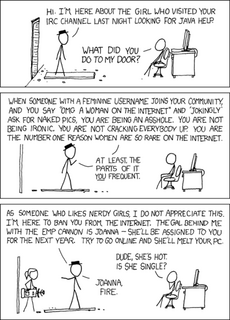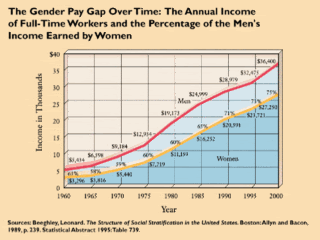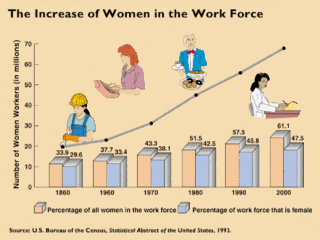Gender Equality
To what extent has gender equality been achieved? What gender biases persist and why?
Daily we hear about how men and women are different. They say we come from different planets.
Gender divides humans into two categories: male and female. This division permeates through society and organises every realm of our lives.
For this discussion I would like to point out that sex is in reference to human biology, that is the physical characteristics of a man or a women and gender is in reference to the social and cultural construction of masculinity and femininity. That is to say that gender is not just what sex a person is but rather the set of meanings that sexes assume, a female body produces feminine behaviours, a feminine identity.
Subsequently gender divides humans into two categories (for the sake of this essay i am excluding other divisions of gender), male and female. What does it mean to be a man or a women, what roles do you have as a male or a female, how do you become masculine or feminine?
“gender difference is also typically the way we explain another universal phenomenon: gender inequality. Gender is not simply a system of classification by which biological males and biological females are sorted, separated and socialized into equivalent sex roles. Gender also expresses the universal inequality between women and men. When we speak about gender we also speak about hierarchy, power and inequality, not simply difference.” (Kimmel, 2000).
Every known society differentiates between men and women and almost every known society is based upon male dominance. “virtually every society known to us is founded upon assumptions of gender difference and the politics of gender equality” (Kimmel, 2000).
Gender means different things to different people, it varies cross culturally and across history however the same universal code of male domination applies. Some cultures encourage women to be decisive and competitive, whereas other cultures teach women to be passive and dependent, there are often dramatic differences between societies regarding gender differences and the level of inequality. There are obviously differences between a women in Australia in the 21st century compared to a women in Afghanistan in the 21st century. Gender identity is the ways in which other differences, race, class, ethnicity, sexuality, age, region, all inform, shape and modify our definitions of gender.
Gender in the workplace
The transformation of men’s and women’s work roles stands out among the many technological, economic, social and cultural changes of the twentieth century.
“In 1950, only a small minority of women (29%) worked outside the home, but in 2000 nearly three quarters of women did. In 1950 women who were employed
worked in a relative handful of nearly exclusively female occupations but by 2000 were spread across nearly the entire spectrum of occupations. Finally, the average woman in 1950 earned 59¢ for every dollar earned by men while in 2000 she earned 73¢.” (Cotter, Hermsen, Vanneman, 2004).
Despite all this progress inequalities still remain in the workplace. Women are still not paid as much as men and still struggle to reach executive positions (http://christinasocialpsych.blogspot.com/2007/10/mens-womens-income.html). However there is nothing inherent in women that make them less likely, as individuals, to be successful in the workplace than men. So why still do differences remain?
For many women, particularly in high powered careers there is a certain social stigma associated with their success, many female politicians in particular have found this. women in politics have been subjected to much public scrutiny. Many female politicians receive excess backlash from the media criticising their dress sense, or making snide remarks regarding their size, weight and personal appearance.
Women who succeed are seen as having sacrificed their femininity. Women who succeed are punished for abandoning their femininity – rejected as potential partners often labelled as dykes.
“women who work enter a gendered institution in which everything they wear “signifies” something. So they look at one business-like dress and tell themselves “No, this is too frumpy. They’ll never take me seriously as a women in this dress!” So they hold up a slinker and tighter outfit and think “in this little number, all they’ll see in me is a women, and they’ll never take me seriously as an employee” Either way- corporate frump or sexy babe – women lose, because the workplace is, itself gendered and standards of success, including dressing for success, are tailored to the other sex.” (Kimmel, 2000).
Sports
From primary school gender socialization regarding sports is considerable. Girls are dressed in skirts and tunics whilst boys are commonly dressed in shorts and t-shirts, subsequently boys can freely run around and play sports at lunchtime whereas girls are far more physically constricted due to dress. Boys are encouraged to be rough and sports. Girls are encouraged to play in small groups in the shade.
The sporting arena has proven to be one of the key institutional sites for the study of the social construction of gender. From a young age we are taught that sport is far more valuable in a male than in a female, the characteristics of sport include competitiveness, physical strength and aggression, typical male traits which when displayed in a female are harshly judged and categorized.
Despite the rising number of women participating in both singular and group sports men’s sports still dominate in commercial value and in the media. Men’s sports are still assumed to be mostly for male spectators and women’s sports, however successful, have to be attractive to men as well as women viewers. As a result notions of conventional masculinity and femininity persist.
There is also the sexualisation of women in sports illustrated. Rather than appearing in the magazine as equal members in the sporting world they appear still as sexualised objects for the predominantly male readership.
Finally women’s sports seem to be largely controlled by men, and increasingly seems to reflect the valued characteristics of men’s sports (hierarchy, competitiveness and aggression). Even when it come to the most feminine sports male coaches are demanding the aggressiveness of adult men and submissiveness of young females. For example women’s gymnastics, where very young girls are typically coached by men who are often abusive and the girls learn to practice with painful injuries and often develop severe eating disorders in order to keep their bodies small.
Domestic violence, sexual assault & rape
The majority of violent crimes are committed by men, about 98 per cent; and the majority of violent crime against women is committed by men they know. In a study of reported rapes in Victoria, it was found that 61 per cent of victims who reported the rape to police were known to their offender (Victorian Community Council Against Violence 1991). Sadly women still fall victim to the larger percentage of domestic violence, sexual assault and rape and mainly for reasons of a familiar males control over them.
Societies where women are honoured, rape rates are exceptionally low, those where women are degraded and devalued rape rates are high. Rape is performed almost exclusively by one gender, men. It has been speculated that rape is an expression of power, of male power over women. It has only been a recent occurrence that women’s rape during the war be viewed a war crime.
Men
It should be mentioned also that men too suffer from gender inequalities. The stigma associated with being as stay at home parent, pressure to support a family, Increasing social isolation and the difficulties in admitting to mental illness and depression.
While we have indeed come along in the field of gender equality there is still along way to go. Although the vast inequalities women once faced are not as visible as they once were but they still exist. It should be said that women’s biological abilities to bear and nurse children might be seen as the expression of such ineffable power – the ability to create life? Maybe one day?
Online engagement
Online engagement for blog 2 has been active. I have regularly posted on my own blog: Please see full blog at http://christinasocialpsych.blogspot.com/ I have also posted on other peoples blogs: Pssssssstttttttt – “Todays Women” at https://www.blogger.com/comment.g?blogID=6760461192885241905&postID=7717133668104543408 and on Josies social psychology blog – “love – where does it fit” at
https://www.blogger.com/comment.g?blogID=8841261988306058751&postID=8181136964412033801
References :
Baumeister, R F., & Bushman, B. J. (2008) Social Psychology and human nature (1st ed.) Belmond, CA: Thomson Wadsworth
Cranny-Francis, A., Waring, W., Stavropoulos, P., & Kirby, J. (2003) Gender Studies: Terms and Debates New York: Palgrave Macmillan
Kimmel, M.S. (2000) The Gendered Society. New York, Oxford University Press
Hargreaves, J. (1994) Sporting Females. Critical issues in the history and sociology of women’s sports. London and New York: Routledge
Tuesday, October 30, 2007
Monday, October 29, 2007
Monday, October 22, 2007
Women and the Knife

I recently red an article (thanks James) entitled: Has Artificial Beauty Become the New Feminism? By Jennifer Cognard-Black, Ms. Magazine. Posted September 29, 2007.
The article raises issues about women and the increasing cosmetic surgery industry and the paradox of choice. The article can be found at: http://www.alternet.org/healthwellness/63683/?page=1
The article critiques the claim that cosmetic surgery is the new feminism and discusses the ways which plastic surgery is becoming more and more mainstream and acceptable in society. Most feminists are the first to adamantly oppose plastic surgery as a tool for a variety of reasons….
In starting a discussion about this topic I have a question for everyone: Cosmetic Surgery. Is this a setting of liberation or oppression – or both?
“Another comparable limitation (of the women’s liberation movement) is the tendency to reject certain good things only in order to punish men… There is no reason why a women’s liberation activist should not try to look pretty and attractive.”(Markovic 1979).
As I talked about in my previous post from when we are young women we are taught (both directly and indirectly) about looking good/pretty/thin/tanned and so on. Cosmetic surgery seems to me to be the manifestation of huge pressure on women to adhere to cultural ideals of beauty. That said is plastic surgery an example of conformity? Woman conforming to the westernized view of attractive, for example, Jewish girls getting their noses redone!!
Most of the argument for plastic surgery is rooted in the idea of choice. Women have the right to choose if they want to change their bodies. They also have the right to choose to use nail technicians, manicurists, dietitians, hairstylists, cosmetologists, masseuses, trainers, electrolysists, pharmacologists and dermatologists!
All these experts transforming the human (particularly female) body into an increasingly artificial and ever more perfect and beautiful OBJECT. To me all of this is an example of the ways a woman’s attractiveness is defined as attractive to men.
When people argue that all these changes are the new way of feminism aren’t they contradicting the whole point of feminism, which I understood to be the valuing of ourselves as who we are… as equals…? Cosmetic surgery is ultimately a way of saying I do not accept myself as I am.
Furthermore the reality is these surgical interventions are nasty, dangerous and risky they can result in infection, bleeding, embolisms, facial nerve injury, scar formation, skin loss, blindness, crippling and even death. What a perfect Christmas gift for your loved one!!!!
The knives and needles of the cosmetic surgeons “what kind of knives are these? Magic Knives. Magic knives in a patriarchal context” (Morgan, 1991)
Again I will put it to everyone: Cosmetic Surgery. Is this a setting of liberation or oppression – or both?
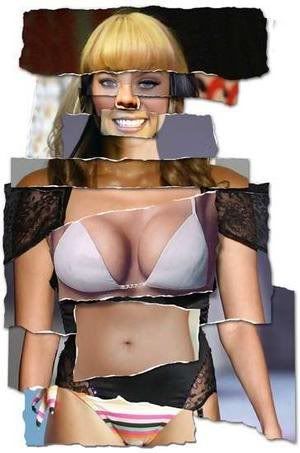
Sunday, October 14, 2007
Gender
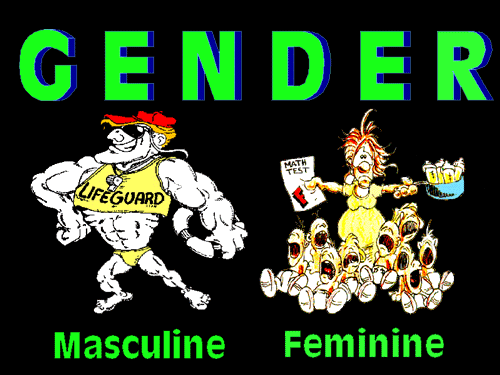
My second blog question is: To what extent has gender equality been achieved? What gender biases persist and why?
I think for this topic that first i should talk a little about the concept of gender.
Gender and a few ideas:
For this discussion I would like to point out that sex is in reference to human biology, that is the physical characteristics of a man or a women and gender is in reference to the social and cultural construction of masculinity and femininity. That is to say that gender is not just what sex a person is but rather the set of meanings that sexes assume, a female body produces feminine behaviours, a feminine identity.
From this we know that gender divides humans into two categories, male and female. What does it mean to be a man or a women, what roles do you have as a male or a female, how do you become masculine or feminine? We all probably realise that becoming our gender is largely influenced by socialisation... From birth we are treated a certain way depending on our sex... so a quesiton for everyone, In what ways do people begin marking a child’s gender after its birth?
When i think about this process of socialisation i consider my life... the way i was dressed a child in pretty pink dresses with ribbons in my hair and encouraged to dance, learn instruments and play with dolls. Obviously it has influenced the way i am now... still loving to wear dresses and look 'pretty'... its interesting to think about the ways we act out our gender. How do you ‘do’ gender?
Just a few starting thoughts, we cant really talk about gender equality without having an understanding about gender!! Next post I will address the topic of gender in culture.
Tuesday, October 9, 2007
PostSecret
This has nothing to do with my blog i just thought eveyone might enjoy it!! I think its really beautiful and interesting. Its funny the way people do actually want to tell their secret.... so long as no one actually knows its theirs...
Subscribe to:
Posts (Atom)
